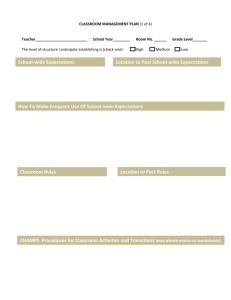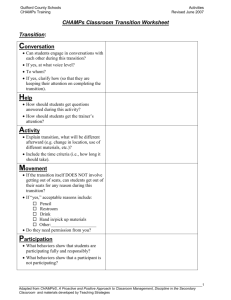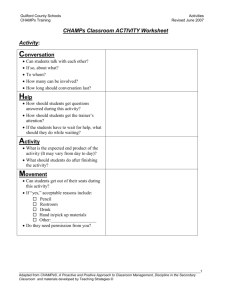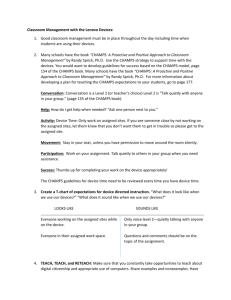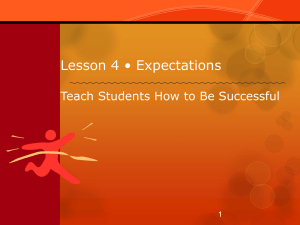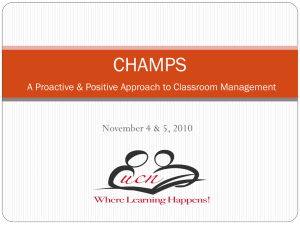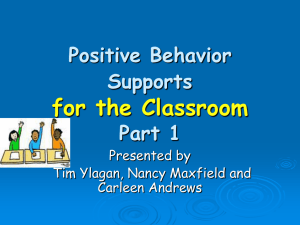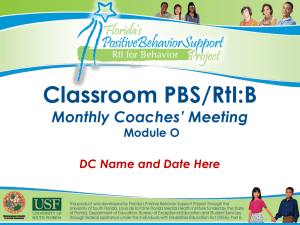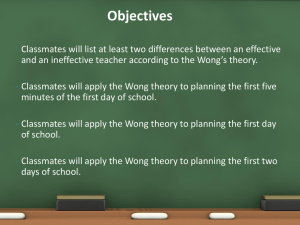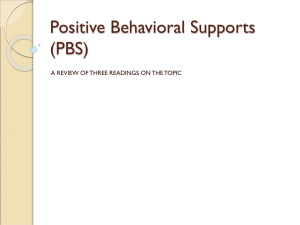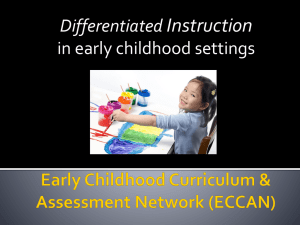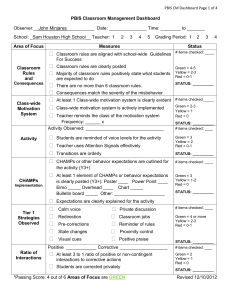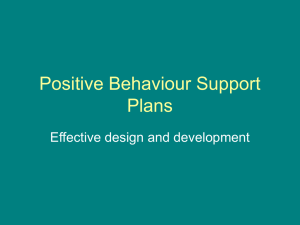Rolling Out CHAMPs
advertisement
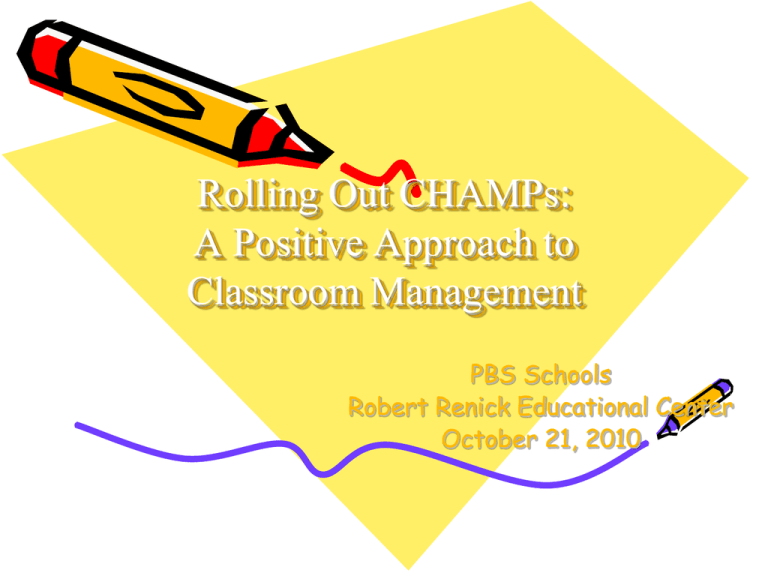
Rolling Out CHAMPs: A Positive Approach to Classroom Management PBS Schools Robert Renick Educational Center October 21, 2010 Objectives • • • • Discuss the Importance of Tier 1 Classroom Review Components of CHAMPS Review Procedures, Expectations, and Rules Components of a CHAMPs Professional Development • Review What has Been Completed Since Last Year’s Training • Design a CHAMPs Professional Development Calendar Classroom PBS • Classroom-Level RtI: Behavior provides tools to: – Support classroom teachers in embedding RtI: Behavior into their classroom practices – Assist classrooms in need of behavioral support in addition to existing school-wide practices Building a Foundation for RtI • Response to Intervention – Classroom Level PBS is a critical step in RtI models • Prevention • Tools for remediation • Room for accommodation – Classroom strategies should be included EARLY in hierarchy of supports Individual Students Small groups of students Rough day in the Classroom classroom Tier 1/Universal Behavior Data Sources for the Classroom • Student At Risk Profile Report (T-0515P71-01) • Suspensions Reports • Attendance Reports • Truancy Reports • School Climate Survey • Course Failures • Conduct Grades • SCM Reports The CHAMPs Acronym C-H-A-M-P-- Conversation Help Activity Movement Participation Safe & Civil Schools 6 CHAMPs • C- Conversation: can students talk to each other during this activity/transition • H- Help: How can students get questions answered during this activity/transition? How do they get your attention? • A- Activity: What is the task/objective of this activity/transition? What is the expected end product? • M- Movement: Can students move about during this activity/transition? Are they allowed to get up to sharpen a pencil? • P – Participation: What does appropriate student behavior for this activity/transition look/sound like? How do students show that they are fully participating? Safe & Civil Schools 7 The Difference between Discipline and Rules Procedures and Routines • Discipline concern how students behave • Discipline plans have rules, consequences and rewards • The purpose of rules is to set boundaries or limits • Procedures concern how things are done and are statements of student expectations • Routines are what the students do automatically • Procedures and routines teach what students are to do or work at. • Classroom management plans have procedures The First Days of School Harry K. Wong, 2009 8 Why Are Procedures Important? • Classroom procedures are statements of student expectations • Classroom procedures allow different activities to take place efficiently • Classroom procedures tell students how the classroom is organized • Classroom procedures increase on task time and greatly reduce classroom disruptions • Classroom procedures tell student how the classroom is organized thus reducing discipline problems The First Days of School Harry K. Wong, 2009 9 Two Kinds of Consequence • Positive consequences or REWARDS result when people abide by the rules • Negative consequences or PENALTIES result when people break the rules The First Days of School Harry K. Wong, 2009 10 Two Kinds of Rules • General Rules: encompass wide range of behaviors – Respect others – Be polite and helpful – Keep the room clean • Specific Rules: Typically focus on particular behaviors. – In class when the bell rings – No offensive language – Hands, feet and objects to yourself The First Days of School Harry K. Wong, 2009 11 Consequences • Consequences are NOT PUNISHMENTS • It is simply what happens when a person does something, a result of a person’s chosen action • It is advisable to spend more time discussing consequences than discussing rules. • Help students understand that their actions or choices result in consequences and consequences can be negative or positive. The First Days of School Harry K. Wong, 2009 12 Classroom Rules • Limit rules to a number that you and the students can readily remember- never more than 5. • If you need more than five rules, do not post more than five at any one time • Rules need not cover all aspects of behavior • It is the teachers prerogative to replace one rule with another at any time • As a new rule becomes necessary, replace an older one with it. The rule you replace can be retained as an “unwritten rule”. The students are still responsible for the one you have replaced. The First Days of School Harry K. Wong, 2009 13 Classroom Expectations and Rules for Success 1. Be responsible 2. Be respectful 3. Be prepared 1. Follow directions first time given 2. Change tasks quickly and quietly 3. Raise hand and wait for permission to speak 4. Keep your voice to an inside working level 5. Report directly to the assigned area Common Transitions Changing classes Beginning and ending routines Moving as a class to a different location (i.e., library, lunchroom) Cleaning up after a group project Moving to and from cooperative groups Top 6 Tier 1 Classroom Practices 1.Teach school-wide expectations 2.Establish/teach procedures & routines 3.Establish/teach effective classroom rules 4.Acknowledge appropriate behavior 5.Actively engage learners 6.Respond effectively to problem behavior So now that we remember, what’s next? Roll-out!!! Revise Classroom Section of PBS Action Plan Planning Schedule • • • • Topics for Professional Development Training Materials Schedule Dates and Times Schedule Training through Center for Professional Learning (CPL) • Trainers Select Topics to Present • Administrative Monitoring of the Techniques Topics for Professional Development: Champs Modules • Module One: Vision – Task 1: Long Range Behavioral Goals (p. 9-11) • Write Four Goals – Administrative Review – Share with Parents and Students – Task 2: Guidelines for Success (p.12-14) • School-wide Expectations – Review with Students – Post in Classrooms – Share with Parents Topics for Professional Development: Champs Modules • Module One: Vision – – – – Task 3: Positive Expectations (p.15-18) Task 4: Family Contacts (p.19-24) Task 5: Professionalism (p.25-28) Task 6: Principals of Behavior • Use PBS Powerpoint • Module Two: Organization – – – – – Task 1: Daily Schedule (p.49-53) Task 2: Physical Space (p.54-60) Task 3: Attention Signal (p.61-62) Task:4: Beginning and Ending Routines (p.63-74) Task 5: Classroom Rules (p.75-77) • Post Rules – Task 6: Student Work (p.78-92) – Task 7: Classroom Management Plan (p.93-98) Training Materials • Develop Powerpoints • Develop Additional Handouts – Activities • Utilize Materials in books and on the CD http://flpbs.fmhi.usf.edu for resources Schedule Dates and Times • Discuss with Administrators • Look at: – – – – Faculty Meetings District Professional Development Days Early Release Days Saturdays, If Funds Exist Schedule Training through Center for Professional Learning (CPL) Teachers will work for Master Plan Points!! Trainers Select Topics to Present Divide the presentation and the responsibilities. No one works alone!!! Administrative Monitoring of the Techniques Let’s Plan and Report What’s Next: Due Dates • Draft Professional Development Schedule: – Today, October 21, 2010 • Revised Classroom Section of Your PBS Action Plan • Finalized Professional Development Schedule: – October 28, 2010 • Completion of First Professional Development: – November 30, 2010 • Attendance Sheet and Handouts • Completion of Second Professional Development: – January 14, 2011 • Attendance Sheet and Handouts • Classroom Visits by PBS Coaches: – April 29, 2011 • Look for Completion of Specific Tasks Thank You For Your Time! Contact Information Ms. Robin J. Morrison, Instructional Supervisor Clinical Behavioral Services rmorrison@dadeschools.net Ms. Sylvia Arango, Curriculum Support Specialist Clinical Behavioral Services sarango@dadeschools.net Ms. Patricia Moore, Curriculum Support Specialist Clinical Behavioral Services PDMoore@dadeschools.net
